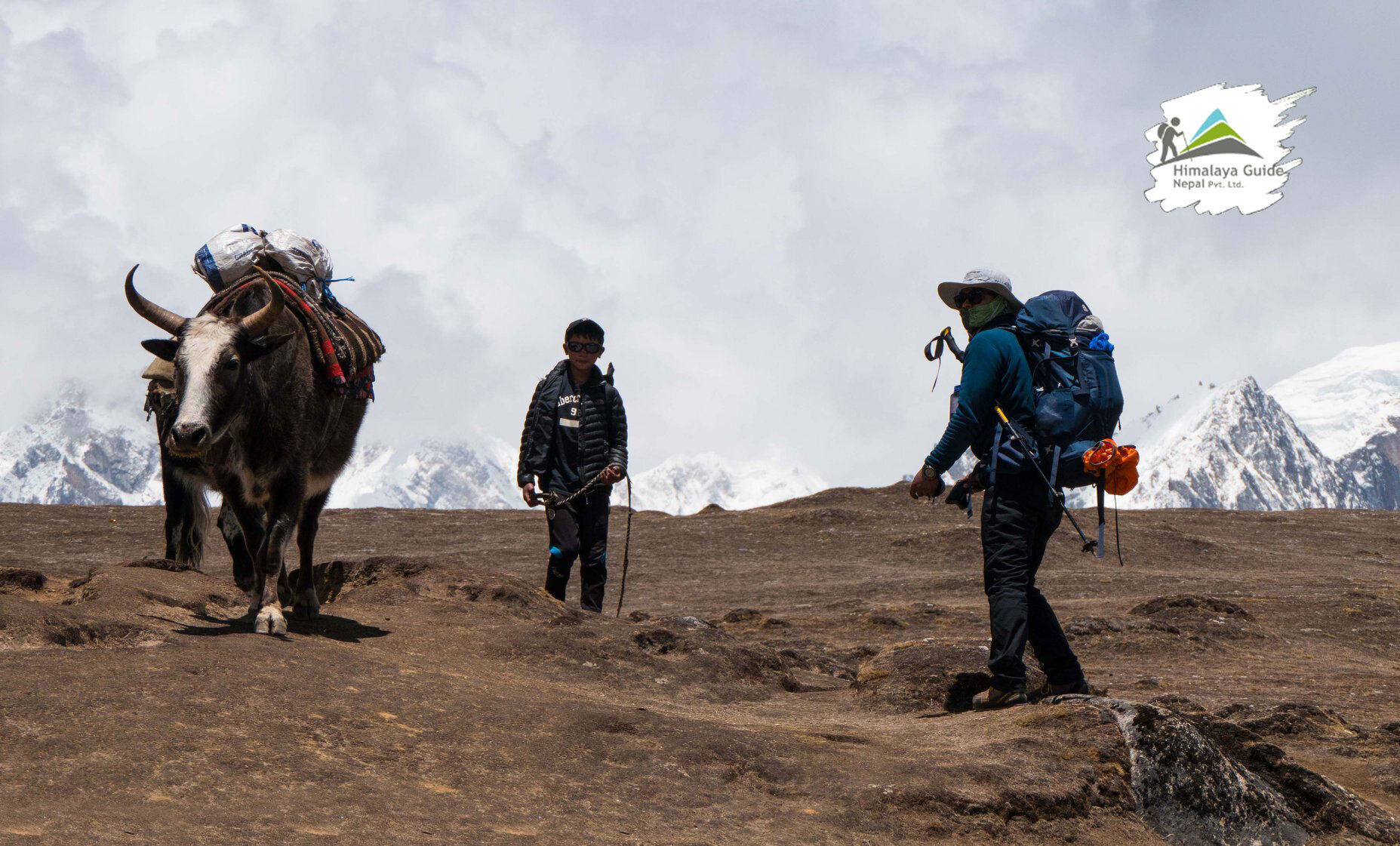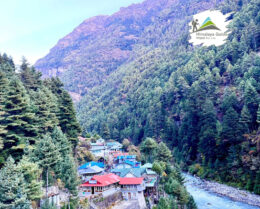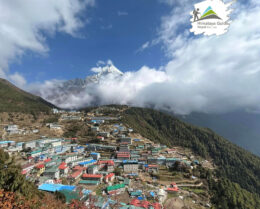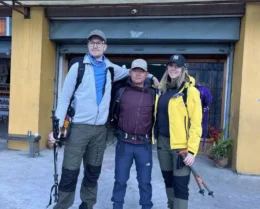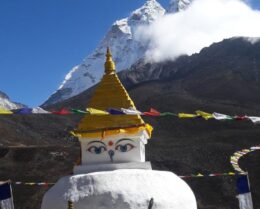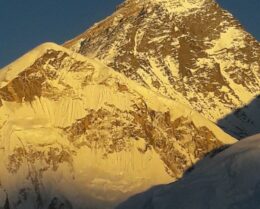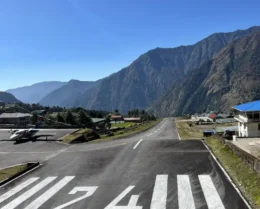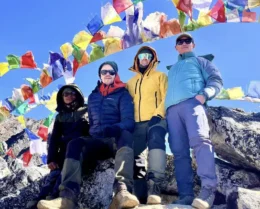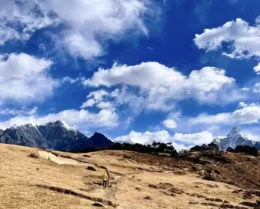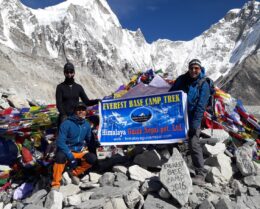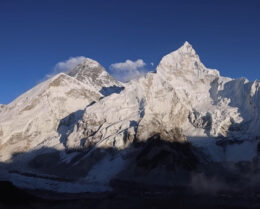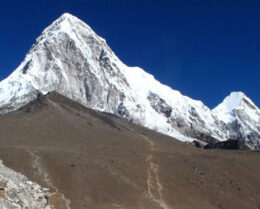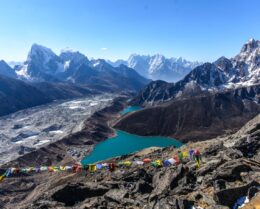Jiri to Everest Base Camp Trek
- difficulty
- Moderate
- altitude
- 5,545m / 18192 ft (Kalapatthar)
- group size
- 1+
- meals
- Breakfast, Lunch and Dinner
- accomodation
- Hotel/Lodge/Tea House
- season
- Sep-Nov to March & April
trip overview
Jiri to Everest base camp trek which is one of the best trekking journeys in Nepal annually a lot of visitors come to this place to enjoy the beautiful landscapes of the place. It takes roughly six hours to drive from Kathmandu to Jiri (2,100m). The route that the early Everest expeditions took to reach Everest Base Camp is still the principal approach to the roadless Sagarmatha (Everest) Region. The Sherpas consider this place home, which they call the Solukhumbu. Of all the ethnic communities in Nepal, this very small community of 8,000 members is the most well-known and respected.
The Sherpas, whose name means “peoples of the east,” Shar-pa, came from eastern Tibet and settled in high valleys south of Mount Everest some 450 years ago, according to their oral history. Numerous families residing in this area have transformed their houses into lodges for trekkers, primarily serving hikers from abroad.
While trekking through the Sherpa communities, we get to appreciate their kind hospitality and share several of their hearths. One benefit of trekking from Jiri is that it aids in your acclimatization to the terrain. This walk spans over 190 km/120 miles, and along its numerous uphill sections, it gains a total altitude of 9,000m, which is significantly higher than Mount Everest! We take the main trail from Namche to the base camp and all its charms. Trekking to the renowned Everest base camp in Nepal is a legendary journey.
Best Time for Jiri EBC Trek
The Jiri Everest base camp trek package includes an exploration of the stunning scenery in the Solu Khumbu region. The two primary trekking destinations at Jiri and Everest base camp are Mt. Everest (5,463 m) and Kala Pattar (5,545 m). Since the Jiri to Everest base camp hiking map indicates the longest trekking path in the Everest Region, the cost of the Jiri Everest base camp package trip is slightly higher.
Jiri EBC treks are best done in the fall and spring, while they can be done any time of year, according to the needs of the trekker. The 195-kilometer journey from Jiri to the Everest base camp begins and ends in Lukla. recommended that for safe travels in the Himalayas, all tourists use local Nepali trekking agencies that are registered with the government.
Additionally, Trekking to Everest Base Camp entails exploring the entire Solu and Khumbu region, which has stunning rhododendron and pine forests, terraced green farms, and numerous ethnic villages. hiking simultaneously in the national parks of Sagarmatha and Gauri Shanker. Jiri to EBC trekking requires a minimum of three weeks off, and being in good physical condition is essential to reaching the top.
Highlights of Jiri to Everest Base Camp Trek
- Edmund Hillary and Tenzing Norgay Sherpa undertook the traditional route for trekking in the Everest Region, the Everest Base Camp Trek via Jiri, during their 1953 attempt to summit Mount Everest.
- The EBC trekking route via Jiri covers the entire Solu and Khumbu region, passing through terraced green farms, stunning rhododendrons and pine forests, and a multitude of ethnic communities.
- The world-famous Tengboche monastery is the biggest gompa in Nepal’s Khumbu region, at a height of 3,867 meters (12,687 ft). Lama Gulu built it in 1916.
- The Khumbu Glaciers, and the Khumbu Icefall all within a three-week trekking vacation in Nepal. Learn about the customs, culture, and hospitality of the Sherpa people.
- Trek through both the Gaurishankar and Sagarmatha national parks in one trip. See four mountains above 8,000 meters and 23 snow-capped mountains.
itinerary
Arrive at Kathmandu 1,300m.
Arrive in Nepal. Once reaching Tribhuvan International Airport, both foreign and domestic travelers must go through immigration procedures.
Drive from Kathmandu to Jiri 1,940m for 8-9 hours.
On 1st day, the adventure commences in Kathmandu, the bustling capital of Nepal, famed for its cultural importance and as a gateway to the awe-inspiring Himalayan location. The destination for the day is the Jiri, located at an elevation of 1,940 meters (about 6,365 ft.) inside the Dolakha District. The selected mode of transportation is by bus with the travel of eight to nine hours.
This implies an afternoon-length road trip through terrains that will consist of valleys, hills, and doubtlessly some mountainous landscapes. The distance covered would depend upon the specific path taken. This journey holds the promise of scenic beauty and the exploration of numerous landscapes.
Jiri to Deurali 2,255m/4-5 hours trek
On the 2nd day of the itinerary, the expedition continues from Jiri to Deurali. The day’s journey includes a trek over a distance of approximately four to five hours, with an expected elevation gain to Deurali at 2,255 meters (around 7,398 feet).
This journey indicates a shift from motorized transportation to on foot, indicating a trekking journey throughout the day.
The course may additionally traverse through various terrains, presenting trekkers with the possibility to immerse themselves inside the beautiful hills and forest of the place.
Deurali to Sete 2,575m/5-6 hours
On the 3rd day of the trek, adventurers will embark on an adventure from Deurali to Sete. Sete, located at an elevation of 2,575 meters above sea level, serves because this is one of the best resting and acclimatizing spots.
The trail is expected to take about 5-6 hours of trekking in the hills, during the trek you need to be careful of the terrain, trekking tempo, and changing weather conditions. This is one of the important parts of the trekking itinerary, which adds to making plans and executing their multi-day journey via various beautiful landscapes.
Sete to Junbesi 2,500m/6-7 hours
On the 4th day of the trek, trekkers will maintain their tour from Sete to Junbesi. Junbesi, situated at an elevation of 2,500 meters, marks the endpoint for this leg of the travel. Moreover, the anticipated length for completing this part of the trek is approximately 6-7 hours. Furthermore, as with all trekking itineraries, the actual time might also range primarily based on factors along with the trail path, hiking pace, and weather conditions.
Rest Day in Junbesi
On the 5th day of the trek, trekkers will take a properly-deserved rest with a designated relaxation day in Junbesi. This pause in the journey allows trekkers to recharge and acclimate to the altitude, supplying the possibility to explore Junbesi’s cultural and natural sights.
Whether it is traveling nearby landmarks, interacting with the people, or enjoying the serene surroundings, the rest day in Junbesi offers a threat for both physical and mental rest. This is an important part of the itinerary which is vital for preserving strength and making sure an extra enjoyable and sustainable trekking enjoy within the days to come back.
Junbesi to Nunthala 2,200m/5-6 hours
On the 6th day of the trek, the adventure resumes with a trek from Junbesi to Nunthala. The trail results in Nunthala, situated at an elevation of 2,200 meters. Trekkers can count on spending about 5-6 hours in this segment of the trek, although the real-time might also range based totally on elements consisting of trail situations, individual strolling tempo, and weather.
This segment of the trek contributes to the overall journey, supplying numerous landscapes and studies along the way. The facts supplied aid trekkers in making plans for their day, considering the time needed to attain Nunthala and bearing in mind modifications primarily based on the conditions encountered at some stage in the adventure.
As with every day of the trek, this leg provides the cumulative enjoyment of the excursion via the captivating terrain.
Nuthala to Bupsa 2,100m/5-6 hours
On the 7th day of the trek, the course unfolds from Nunthala to Bupsa. The trek contains a distance that culminates at an altitude of 2,100 meters. Trekkers must allocate approximately 5-6 hours for this leg of the adventure, spotting that the actual period may be motivated with the aid of variables including path complexity, strolling tempo, and winning climate conditions.
As the excursion progresses, each day presents its unique challenges and rewards, contributing to the overall journey. The information furnished for Day 07 serves as a guide, supporting trekkers plan their itinerary and making sure a properly-paced exploration of the terrain among Nunthala and Bupsa. Adjustments may be made as hard to accommodate the evolving conditions of the trek.
Bupsa to Cheplung 2,535m/6-7 hours
On the 8th day of the trek, the adventure advances from Bupsa to Cheplung. The trail ends in Cheplung at an elevation of 2,535 meters, overlaying a distance that is expected to take about 6-7 hours. As trekkers travel from Bupsa to Cheplung, they will encounter diverse landscapes and experience the unique factors of the place.
Cheplung to Monjo 2,710m/4-5 hours
On the 9th day of the trek, the route spans from Cheplung to Monjo, each located at an elevation of 2,710 meters above sea level. This section of the journey is anticipated to take approximately 4-5 hours to finish. The facts are an essential part of a larger trekking itinerary, revealing the challenges and highlights of the path.
Trekkers can make use of that info to gauge the space, plan their time correctly, and put together the specific conditions that could arise in the mountainous terrain.
Monjo to Namche Bazaar 3,410m/5-6 hours
On the 10th day of the trek, the journey proceeds from Monjo to Namche Bazaar. Starting at an elevation of 2,710 meters in Monjo, trekkers will ascend to the better elevation of Namche Bazaar at 3,410 meters. This leg of the trek is expected to take approximately 5-6 hours, encompassing a direction that could give varying terrains and scenic landscapes.
Namche Bazaar, a widespread point within the trek, now not most effective marks a considerable elevation advantage but also gives trekkers the precise attraction of a mountain metropolis.
Trekkers are cautioned to take into account the challenging ascent, plan for breaks, and be organized for modifications in weather and trail conditions all through this part of the adventure.
Acclimatization Day at Namche (Hike to Everest view Hotel 3,800m.)
On the 11th day of the trek, participants will engage in an essential acclimatization day at Namche. Acclimatization is vital for adapting to higher altitudes and stopping altitude-related issues. As a part of this acclimatization manner, an optionally available hike to Everest View Hotel, situated at 3,800 meters, is recommended.
The trek offers now not only the best possibility for sluggish altitude adjustment but also rewards trekkers with breathtaking perspectives of the Everest vicinity. The day’s timetable allows for relaxation, exploration of Namche, and participation in altitude-unique sports, ensuring well-being and preparing the trekkers for the challenges to come.
Namche to Tyangboche 3,800m/4-5 hours)
Embarking from the colorful city of Namche Bazaar, the trek closer to Tyangboche unfolds a captivating adventure amid the Himalayas and alongside the enthralling Dudh Koshi River. As the trail steadily ascends, offering awe-inspiring perspectives of iconic peaks, including Everest and Ama Dablam, trekkers navigate via rhododendron forests and suspension bridges, gaining 360 meters in elevation.
The vacation spot, Tyangboche, boasts the famed Tyangboche Monastery, a nonsecular haven embellished with prayer flags and surrounded by panoramic vistas. After exploring this cultural gem, trekkers retire for the night in Tyangboche, immersed in the tranquil environment of the Himalayan landscape.
Tyangboche to Dingboche 4,200m/4-5-hour trek
Embarking on the trek from Tyangboche to Dingboche, adventurers traverse diverse landscapes, ascending four hundred meters to attain the picturesque village. The trail unfolds panoramic perspectives of Ama Dablam and other majestic peaks, growing a captivating backdrop for the journey.
Upon arrival in Dingboche, a settlement nestled in the Khumbu Valley, trekkers are afforded the possibility to explore its specific charm whilst acclimating to the growing altitude. This section of the trek not simplest showcases the Himalayan beauty but also allows for a gradual adjustment to the excessive-altitude conditions, making sure a fulfilling and properly-paced adventure.
Acclimatization Day in Dingboche (4,410m)
Dingboche is a Sherpa village situated at an elevation of 4,410 meters (14,470 feet). In the Khumbu region of northeastern Nepal. Dingboche serves as a crucial acclimatization factor, and dedicating a relaxation day in this tranquil village ensures trekkers adapt nicely to the excessive altitude. Embracing the want for acclimatization, adventurers have the choice to embark on quick hikes inside the region, aiding the adjustment system.
These exploratory jaunts no longer offer a mild bodily activity but also offer possibilities to visit the surrounding Himalayan panorama, such as perspectives of towering peaks like Lhotse and Makalu.
The rest day in Dingboche encourages trekkers to loosen up and appreciate the serene environment, fostering a feeling of well-being before continuing the exhilarating adventure via the Everest Region.
Dingboche to Lobuche 4,950m/4-5 hours walk
Starting on the following leg of the trek, adventurers go away from Dingboche for Lobuche, ascending a substantial elevation of 750 meters. The path unfolds breathtaking perspectives of iconic peaks inclusive of Thamserku and Kangtega, growing a lovely backdrop towards the extensive expanse of the Khumbu Glacier.
As trekkers traverse the rugged terrain, the encircling landscapes offer a charming spectacle of the Himalayan beauty. Upon accomplishing Lobuche, a remote settlement nestled amidst those awe-inspiring mountains, trekkers settle in for the night, surrounded by the tranquility of the high-altitude surroundings, making ready for the ongoing exploration of the Everest Region.
Lobuche to Gorakshep 5,100m and Everest Base Camp 5,350m Visit overnight at Gorakshep 5-6 hours walk in total
The trek from Lobuche to Gorakshep unfolds a challenging ascent to an elevation of 5,100 meters, leading adventurers via rugged terrain and presenting breathtaking views of the Himalayan landscape. Upon attaining Gorakshep, a high-altitude agreement, trekkers prepare for a first-rate afternoon adventure by journeying Everest Base Camp at an elevation of 5,350 meters.
This iconic vacation spot offers a firsthand encounter with the awe-inspiring Khumbu Icefall and offers panoramic perspectives of the encompassing peaks, including the towering Everest. After this exhilarating exploration, trekkers descend to Gorakshep for a properly deserved overnight stay, surrounded by the sheer magnificence of the Everest Region.
Gorak Shep to Kala Patthar 5,555m for sunrise view then back to Pheriche
Embarking on an early morning adventure, trekkers ascend to the summit of Kala Patthar at an elevation of 5,555 meters, wherein they’re rewarded with a panoramic sunrise landscape over the Himalayas.
The awe-inspiring views consist of the majestic Everest, revealing its grandeur in the morning light. After savoring the accomplishment of accomplishing Kala Patthar, trekkers return to Gorakshep earlier than descending to the decreased altitude of Pheriche at 4,240 meters.
Along the descent, the scenic landscapes and captivating views accompany the feel of fulfillment, providing a nicely-rounded experience of the Everest vicinity. The overnight life in Pheriche offers a danger to rest and mirrors the tremendous journey through this high-altitude terrain.
Pheriche – Tyangboche to Namche 3,440m/5-6 hours walk
The descent from Pheriche to Tyangboche takes trekkers through a captivating adventure amidst the beautiful panorama of the Everest vicinity.
As adventurers descend to decreased altitudes, they can savor the changing surroundings and the serene atmosphere. Revisiting the enduring Tyangboche Monastery adds a religious dimension to the trek, making an allowance for reflection and appreciation of the cultural richness embedded in the Himalayan terrain.
The return to Tyangboche offers a possibility to rest and soak up the tranquility of the environment, presenting a second for trekkers to mirror the demanding situations and achievements of the trek at the same time as basking in the serene atmosphere of this culturally significant destination.
Namche – Phakding to Lukla 2,650m/4-5 hours
The return journey continues as trekkers descend from Tyangboche to Namche Bazaar, gracefully navigating the trail to an elevation of 3,440 meters. Of course, they can get pleasure from the scenic splendor one ultimate time, bidding a fond farewell to the high-altitude landscapes that have been their backdrop all through the trek.
The overnight stay in Namche Bazaar gives a final chance to immerse themselves inside the particular atmosphere of this bustling mountain city.
The trek culminates with a descent from Namche Bazaar to Lukla, reaching an elevation of 2,650 meters. As trekkers make their manners down, they can celebrate the completion of the tough and worthwhile journey with fellow adventurers, reflecting on their shared studies and accomplishments.
The nighttime in Lukla gives a coming conclusion to the trek, permitting trekkers to unwind, have fun with their achievements, and proportion testimonies in their memorable expedition. The overnight stay in Lukla serves as a snug resting point before departing from this mountainous enclave, concluding the exceptional journey through the coronary heart of the Everest location.
Lukla – Ramechhap to Kathmandu 1,350m
From Ramechhap, adventurers embark on a picturesque force to Kathmandu, located at an elevation of 1,350 meters. During this journey, trekkers can replicate the challenges overcome, the breathtaking landscapes explored, and the cultural encounters skilled at some point of the Everest vicinity trek.
Arriving in Kathmandu marks the celebratory go back to the colorful capital, imparting an evaluation of the beauty of the mountains.
what's included
- Airport Pick up and drop services.
- Kathmandu to Jiri by public bus.
- Lukal to Manthali by plane and drive to Kathmandu by van.
- Both ways airport taxes.
- Three meals a day; Breakfast, Lunch, and Dinner during the trek.
- Lodge accommodation during the whole trek.
- An experienced guide (Included Salary, Food, Lodge, Insurance, Airfare, Equipment, Transportation, etc.)
- Legal document; GCAP, National Part fee, Local government fee, and Guide permit.
- Equipment: Down Jacket, Sleeping Bag trekking.
- All taxes.
- Trekking and city map.
- First aid box.
- Trekking duffle bag, if needed.
- Token of love from a company.
- Farewell lunch/dinner is a suitable time.
what's excluded
- Travel insurance
- Personal expenses; phone calls, internet, and buying something.
- Porter services; If you need them, we are happy to organize them.
- Hot and Cold drinks; coke, mineral water, beer, etc.
- Tips for staff.
Fixed Departure
| departure date | price | |
|---|---|---|
| 5 Apr, 2025 - 24 Apr, 2025 | $1205 | Enquire Now |
useful info
Difficulty
The Jiri to Everest Base Camp trek is taken into consideration though because of its extended length and varied terrain. The trek taking off from Jiri involves traversing undulating landscapes, crossing excessive-altitude passes, and negotiating rugged trails.
The basic problem is intensified with the aid of the want for acclimatization to prevent altitude-associated troubles as the trek profits elevation. Trekkers must be in precise physical condition and adequately prepared for long, disturbing days on foot.
Acclimatization
Acclimatization is essential at the Jiri to Everest Base Camp trek because of the widespread altitude advantage. It’s beneficial to spend extra days at key places which include Namche Bazaar, Dingboche, and Pheriche to permit the frame to adjust to higher elevations. Engaging in facet hikes all through acclimatization days aids in the process. Adequate hydration and a gradual ascent help mitigate the chance of altitude illness and ensure a more secure and extra exciting trek.
Best Time to Visit
The ultimate time for the Jiri to Everest Base Camp trek is at some stage in the pre-monsoon (spring) and submit-monsoon (fall) seasons. From March to early June and from September to November, the weather is fairly stable with clean skies and slight temperatures. During these periods, the landscapes are colorful with blooming plants or autumn colors, and visibility is super, supplying stunning views of the encompassing peaks.
Safety and Security
Safety is of paramount attention throughout the Jiri to Everest Base Camp trek. Trekkers need to be equipped with the right equipment, such as strong hiking boots, heat garb, and a terrific high-quality backpack.
Hiring a skilled guide and hiking with a reputable agency enhances safety, as they’re acquainted with the terrain and might offer help in case of emergencies. Keeping abreast of weather forecasts and path situations is important for making informed decisions throughout the trek.
In terms of safety, the Everest location is usually secure for trekkers. However, it is advisable to stay informed approximately the present-day tour advisories and exercise warnings in far-flung areas. The trekking community is close-knit, and collaboration with fellow trekkers, guides, and neighborhood communities contributes to a more secure and extra-fun adventure.
As with any adventure, common-experience precautions, respecting local customs, and adhering to responsible trekking practices decorate the overall protection and protection of the Jiri to Everest Base Camp trek.
FAQ
How far is Jiri from Kathmandu?
The lack of straight roads causes the 184 km ride to take longer than expected. Jiri is situated in the eastern hills of Nepal at an elevation of 1,905 m (6,250 ft).
The journey there from Kathmandu takes between 6 to 8 hours. The lack of straight roads causes the 184 km ride to take longer than expected.
What is Jiri famous for?
How many days to go to Everest Base Camp from Jiri?
Can you see Everest from Lukla?
Can you climb Everest for free?
Why is the Everest Region so expensive?
review
Robert AndreasSwedish
Jiri to Everest Base Camp Trek 2023
After long years of planning, we decided on our holiday in Nepal. Then we choose Jiri Everest Base Camp Trek – 2023. We contact the local trekking company Himalaya Guide Nepal. Mr. Chandra Gurung responded to us very quickly and with perfect information. And booked this with them.
Our guides were Bashu Gurung and Porter Damber Magar, the guide was very informative and Porter was a very strong guy for the whole trek. We enjoyed our trek in Nepal. We highly recommend this trekking company for your trip to Nepal.
Thanks


